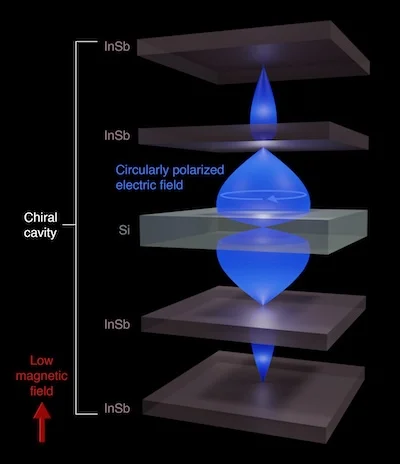
Scientists at Rice University have developed a groundbreaking way to control the behavior of materials by reshaping the “vacuum” around them.
While we often think of a vacuum as empty space, in quantum physics, it’s actually full of tiny, fleeting energy fluctuations known as virtual photons.
These invisible bursts of energy can interact with materials in powerful ways—and now, researchers have figured out how to use them to engineer entirely new forms of matter.
This research, published in Nature Communications, was led by Professor Junichiro Kono and a team of international collaborators.
They built a special kind of optical device called a “chiral cavity,” which uses mirrors to trap and shape these quantum fluctuations. Unlike previous designs, which required strong magnetic fields, their new cavity can control the direction of quantum fluctuations using only a very weak magnetic field.
The team constructed the cavity using a material called lightly doped indium antimonide, a common semiconductor used in infrared technology.
By combining this material with a photonic-crystal structure, they created a cavity that selectively enhances vacuum fluctuations of circularly polarized light in only one direction—a property called chirality. This allows scientists to manipulate the internal properties of any material placed inside the cavity without applying strong external forces.
In previous attempts to achieve chirality in cavities, scientists had to use intense magnetic fields, which often caused unwanted changes in the materials themselves. This new design, however, works with much weaker fields, making it more practical and precise.
“This has been a notoriously difficult challenge,” said lead author Fuyang Tay. But with this new approach, they’ve shown that it can be done efficiently and reliably.
To test how their chiral cavity might affect real materials, the researchers focused on graphene—a single-atom-thick sheet of carbon known for its incredible strength and conductivity. Using advanced simulations and a blend of classical and quantum theories, the team predicted that placing graphene inside the cavity would turn it into a special type of insulator. This transformation opens up exciting new possibilities for quantum computing, where such insulating materials are essential.
The researchers built their predictions using a layered approach: mapping out the electromagnetic fields with classical physics, modeling the graphene’s electronic properties using density functional theory, and analyzing light-matter interactions with quantum electrodynamics. This combination allowed them to make realistic and highly detailed predictions about how materials would behave in the chiral cavity.
“Our design shows that you can transform the fundamental properties of a material simply by placing it inside a specially engineered space,” said Professor Kono. “It opens the door to an entirely new way of creating quantum materials.”
This technology could have wide-reaching applications beyond graphene, helping scientists discover and design other novel materials just by tweaking the quantum vacuum around them.
By turning vacuum into a powerful engineering tool, this research lays the foundation for the next generation of quantum devices and materials.



